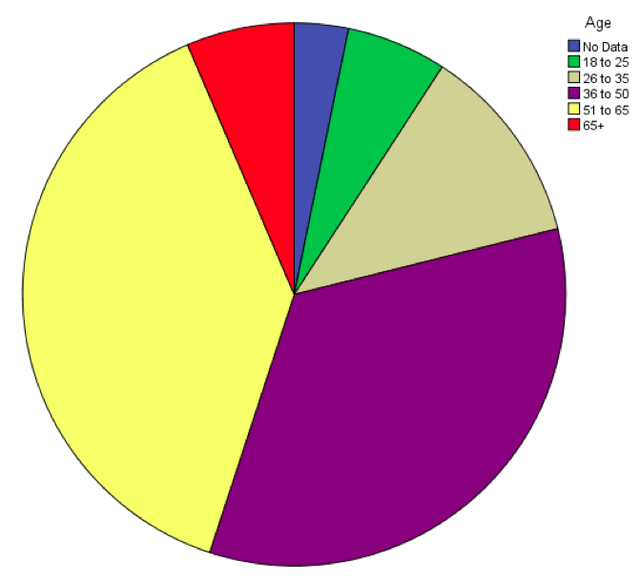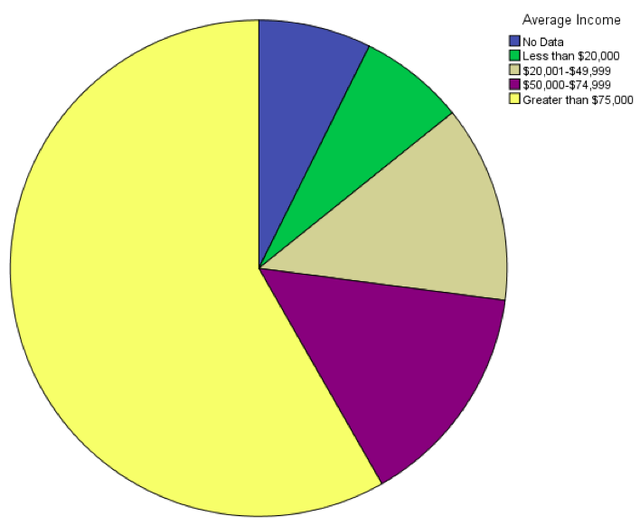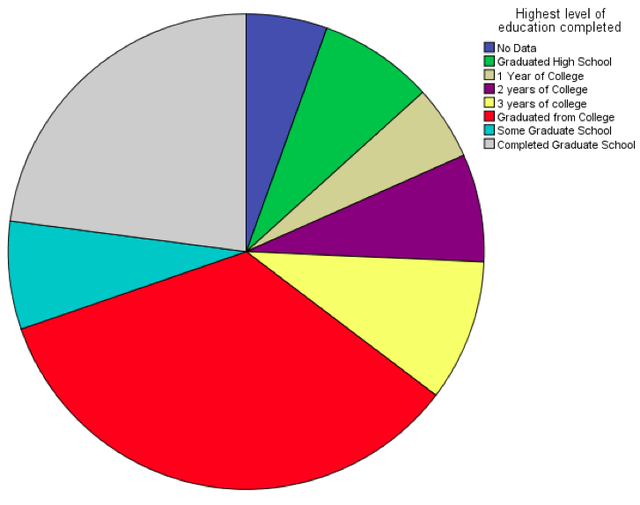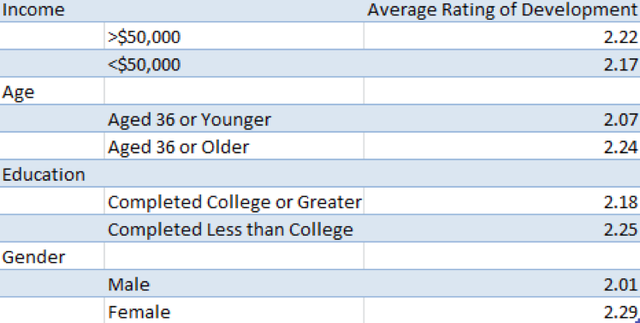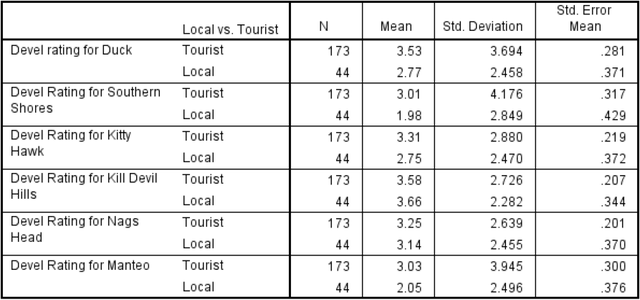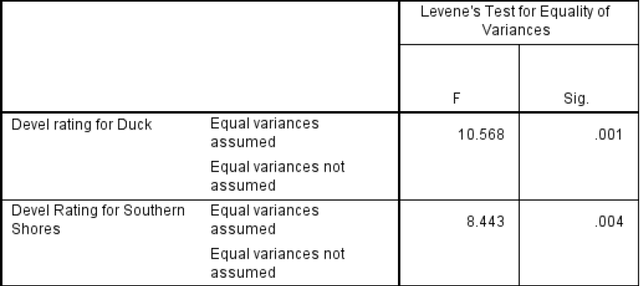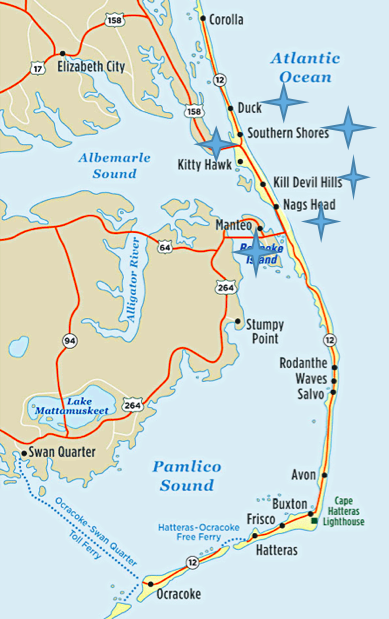Development on the Outer Banks: A Case of Public PerceptionMethodologyAs described above, the purpose of this study was to (1) measure how developed the Outer Banks are and (2) determine whether differences exist between local residents and visitors (those who are on the Outer Banks for less than four months in a calendar year), among other correlations (i.e. income, education, age, etc.) concerning their respective rating of development on the Outer Banks. The purpose of this section is fourfold. First, this section aims to describe the research methodology of the study. Second, this section seeks to explain how and why the sample selection was chosen. Third, the section explains how the questionnaire was developed and how it was used. Lastly, an explanation of the statistical procedures used to analyze and make sense of the data will be provided. Research MethodologyA mixed method (quantitative and qualitative) approach was used for this study. The study was quantitative insofar as addressing the first goal of the project, to determine an average rating of development for the Outer Banks region as well as for collecting various socio-demographic variables discussed below. The collection of the data was accomplished using a semi-structured fifteen question questionnaire (see appendix 1) which focused mainly on prompting respondents to assign an average rating of development to both the Outer Banks as a whole, and each individual town (six in total) making up the Outer Banks. The ratings were generated via a Likert response scale (rating scale) question in which respondents rated their answer to the two categories above on a negative 5 to positive 5 scale, in which negative 5 suggested extremely underdeveloped, while positive 5 suggested extremely overdeveloped. Other quantitative variables such as length of time spent on the Outer Banks (per year), years visiting the Outer Banks, education level, income, age and gender were asked using multiple-choice and dichotomous style questions. Two qualitative based questions were also asked and included “Do you spend time in any other coastal community along the Outer Banks or east coast?” and “In your opinion, what best describes overdevelopment on the Outer Banks?.” The questionnaires were distributed opportunistically and a convenience-based survey approach was used. A convenience-based approach is a non-probability sampling technique in which participants are chosen based on convenience and proximity to the researcher. Although this method is subject to bias based on the researchers discretion, this method is extremely practical and represents an ideal option when funds are limited, perhaps explaining why this technique is often carried out in undergraduate and even graduate level work (Leard, 2014).The questionnaires were distributed in each town along the Outer Banks (Duck, Southern Shores, Kitty Hawk, Kill Devil Hills, Nags Head and Manteo) to adults (ages 18 and older) throughout the summer of 2014 (May-July). The reason for the sampling time is that the summer months best represented the chance to attain both a visitor perception of development (as it is the height of the tourism season) in addition to a local perception. Questionnaires were distributed in shopping centers, restaurant areas, piers, downtown districts and boardwalks in an effort to engage a diverse population in regards to socio-economic variables (income, education, gender, etc.). The results generated from the survey were coded and analyzed using the Statistical Package for the Social Sciences (SPSS), specifically relying independent samples t-tests and bivariate analysis in an effort to make statistically significant correlations within the data set. In addition, the two qualitative questions above were analyzed using summative content analysis, in which keywords and words occurring numerous times within the responses were compiled, followed by an interpretation of the underlying context. ResultsIn total, 218 survey responses were collected over the two month span of research. Of the 218 total survey respondents, 38% were ages 51-65, 33% were ages 36-50, 18% were ages 25 and below, 6% were ages 65 and older and 5% did not provide an age (see figure 2). The gender distribution in the study was nearly equally divided, with 52% of respondents being female and 44% being male (4% did not provide a gender). The average income captured in the study (see figure 3) was “greater than $75,000” (58%), 15% reported an income of $50,000-$75,000, 22% reported an income of below $50,000 and 5% of respondents did not provide an income. Of the respondents 34% completed an undergraduate degree, 22% completed a graduate or professional degree, 21% did not complete college, 8% had attained a high school diploma, 7% had some graduate or professional education, and 8% did not provide a response (see figure 4). Figure 2. Age Distribution of the sample (n=218) Figure 3. Income Distribution for sample (n=218)' Figure 4. Attained Education Distribution for the sample (n=218) As mentioned above, independent t-tests were performed in an attempt to find significant correlations between variables. In essence, there were a large number of non-significant correlations made within the variables. For example, there was little difference of the average rating of development with respect to the classic socio economic variables including income levels, level of attained education, age or gender (see table 1). The most significant correlation drawn from the results comes from analyzing the relationship between the differences in development ratings between tourists and local residents, using the average rating of development for the entire Outer Banks scale (-5 to +5) and, using the same scale, the average development rating of each individual town within the study area (Duck, Southern Shores, Kitty Hawk, Kill Devil Hills, Nags Head and Manteo, see figure 5). Using independent t-tests, the results showed that although local residents, on average, rated the entire Outer Banks as more developed than visitors (local resident rating= 2.50, visitor rating=2.14), when it came to each individual town (Duck, Southern Shores, Kitty Hawk, Kill Devil Hills, Nags Head and Manteo), local residents rated each individual town (i.e. each town in the study area, not just their “own” town) as less developed than tourists for five out of the six towns (see table 2). In addition, correlations for two of the towns (Duck and Southern Shores) turned out to be significant, meaning that the difference in ratings between local residents and visitors for the two towns was statistically different and significant (see table 3). That being said, the information can also be interpreted such that visitors rated the Outer Banks as a whole as less developed than tourists did; however on a town by town basis, visitors rated five out of the six towns as more developed than did the local residents. Table 1. Variables with sub-groups & corresponding development rating (-5 to +5) Table 2. Average Development Ratings for each individual town (mean), stratified by visitors (tourists) and locals Table 3. Results from an independent samples t-test showing the significance values of the relationship described above (p value= .05) Figure 5. Towns of the Outer Banks included in the study, marked by stars Although most correlations and t-tests yielded non-significant results, the finding presented above shows a distinct difference in development rating between visitors and local residents on the basis of the rating for the Outer Banks as a whole and the Outer Banks represented by individual towns. The implications of this finding will be discussed more the in discussion section below. The second major finding of this project came from using keyword content analysis of survey responses, as described above. After using keyword content analysis, the results from Question 9 of the questionnaire (What best describes overdevelopment on the Outer Banks?) showed that the following five themes appeared the most frequently: density (34 times), McMansions, a local colloquialism to describe large beachfront houses (31 times), traffic (22 times), commercialization (21 times) and shopping centers (19 times). However, once again a difference existed between the themes of the local residents compared to those of visitors. The top five themes of visitors were McMansions (27 times), density (25 times), traffic (19 times), commercialization (17 times) and shopping centers (16 times). The top five themes from the local respondents were density (9 times), lack of green space (6 times), McMansions/hotels/commercialization (4 times), Wing’s Stores, a typical beach-ware store found along many beach locales along the east coast (3 times) and traffic (2 times). The meanings and implications of this data will be discussed in depth in the discussion section below. DiscussionThe first noteworthy result from the data is that although there were substantial differences in the socio-economic fabric of the sample area (in regards to income, education, age and gender), no significant differences existed in regards to the corresponding ratings of development. This, however, correlates with results from work by Smith and Krannich (2000), noted above. They reported that although significant socio-economic differences existed within their sample population, their results indicated “very similar levels of concern” (pg. 417) for most of the variables measured. These results were indeed unexpected to Smith and Krannich (2000) as well as to me, as it seems only logical that socio-demographic differences should result in attitude or perception differences. As described above, perhaps the most significant finding of this work is that differences exist between local residents’ and visitors’ ratings of development on the Outer Banks, specifically in regards to rating the Outer Banks as a whole and the towns making up the Outer Banks individually. To reiterate, the data suggested that local residents, on average, rated the Outer Banks, as a whole, as more developed than visitors (although not statistically significant). However, when asked to rate development each of the six towns making of the Outer Banks (an individual rating), local residents rated five out of the six towns as less developed than visitors (of which two of the cases were statistically significant). This can also be interpreted as visitors rating the Outer Banks, as a whole, as less developed than local residents rated them, while rating the five out of six towns (individually) which make up the Outer Banks more developed than did the local residents. Unfortunately, there is not much literature offering possible theories to explain such a phenomena, yet some factors to consider may lend themselves to positing a theory. One reason which may explain the difference in local residents/visitors rating of development between the Outer Banks as a whole and as six towns individually is the idea that economic opportunity may contribute to the rating (insofar as the local residents are concerned). Local residents, perhaps, may perceive the Outer Banks, as a whole, as becoming more developed, as that is how it is portrayed in local media. However, when it comes to their individual town, local residents may be more lenient towards development if economic opportunity comes with it. As for the opposite view (tourists think the Outer Banks, as a whole, is less developed than the towns individually), that may be the result of an embedded vision of the Outer Banks, especially for visitors visiting for many years in a row. Visitors, when they consider the Outer Banks as a whole, may have in their mind, an idea of a rugged, wild Outer Banks, as the region once was, but when they consider each individual town, negative feelings concerning the development of the town (more specifically the one the visitor stayed in) could lead them to rate the individual towns as more developed than the Outer Banks as a whole. The second significant finding came from the keyword content analysis following the responses to question nine of the survey which read “What best describes overdevelopment on the Outer Banks?.” The content results were also stratified into the two groups of local residents and visitors. To reiterate, the top five themes of visitors were McMansions (27 times), density (25 times), traffic (19 times), commercialization (17 times) and shopping centers (16 times) while the top five themes from the local respondents were density (9 times), lack of green space (6 times), McMansions/hotels/commercialization (4 times), Wing’s Stores (3 times) and traffic (2 times). These results suggest that although there is some overlap, visitors and local residents value different things in terms of a smartly developed, sustainable community. Two themes of interest are significant in this set, the two being shopping-centers (which appears fifth on the visitors list, and not at all on the local resident list) and lack of green space (which appears second on the local resident list and not at all on the visitors list). The fact that “shopping centers” does not appear on the local residents’ list suggests that they may be more open to amenities which make daily life easier, while visitors, who are there for typically one week, do not want to see them on their idyllic getaway vacation. This is similar to the idea presented above which stated that local residents may be more receptive to development if it brought with it economic opportunities and in this case, ease of living. The fact that “lack of green space” appears second on the local resident list and does not appear at all on the visitors lists suggests once again, that visitors are mainly concerned with what will affect their week at the beach, while local residents tend to be more concerned with community-based, long term issues, such as a lack of green space in the community. This idea aligns with previous research done by Hao et al., (2010), who through a similar survey study in the same region (Dare County), determined that permanent residents considered many more qualities to be important throughout the tourism development process than did second-home owners and visitors.Continued on Next Page » Suggested Reading from Inquiries Journal
Inquiries Journal provides undergraduate and graduate students around the world a platform for the wide dissemination of academic work over a range of core disciplines. Representing the work of students from hundreds of institutions around the globe, Inquiries Journal's large database of academic articles is completely free. Learn more | Blog | Submit Latest in Environmental Studies |

